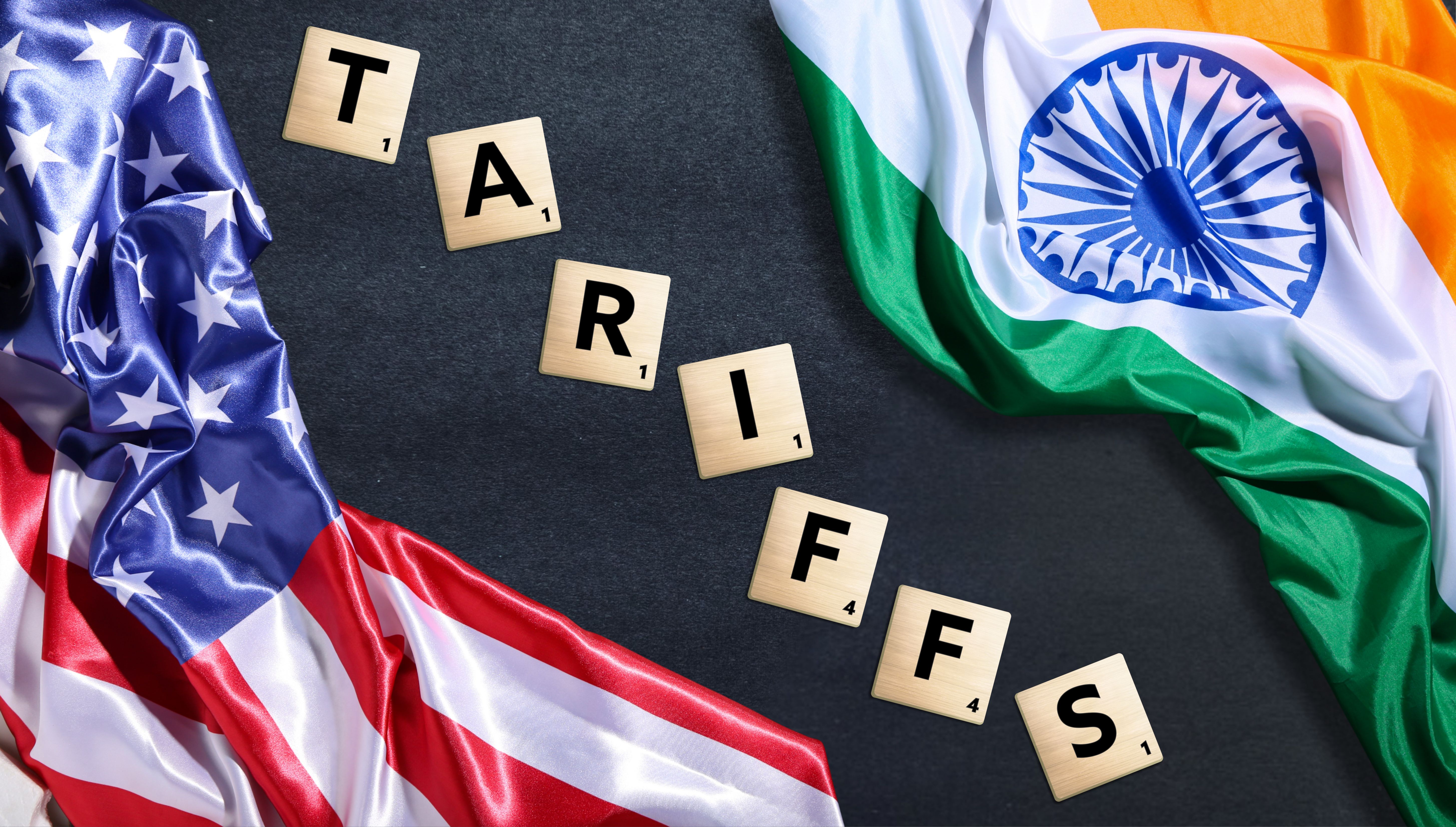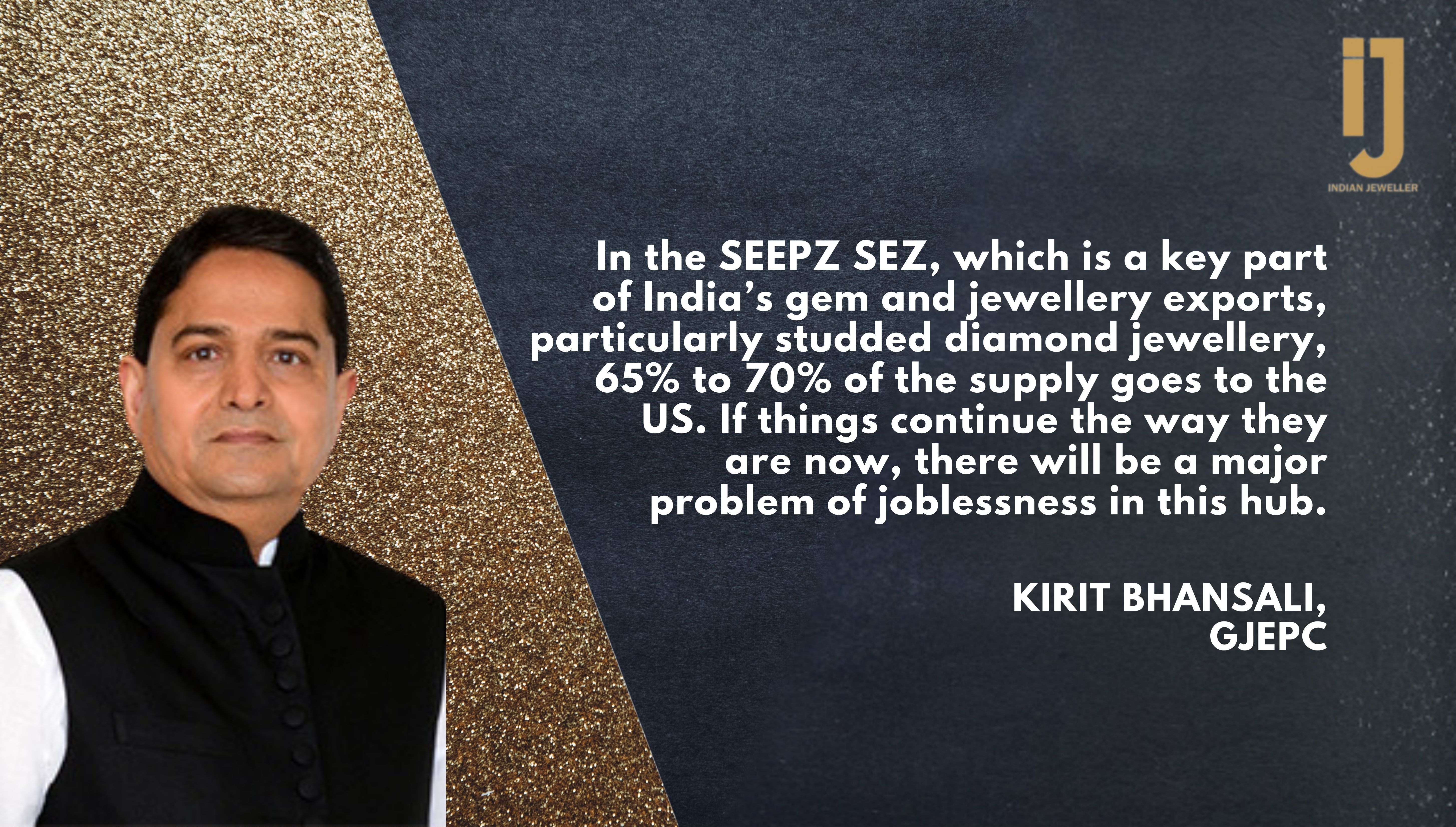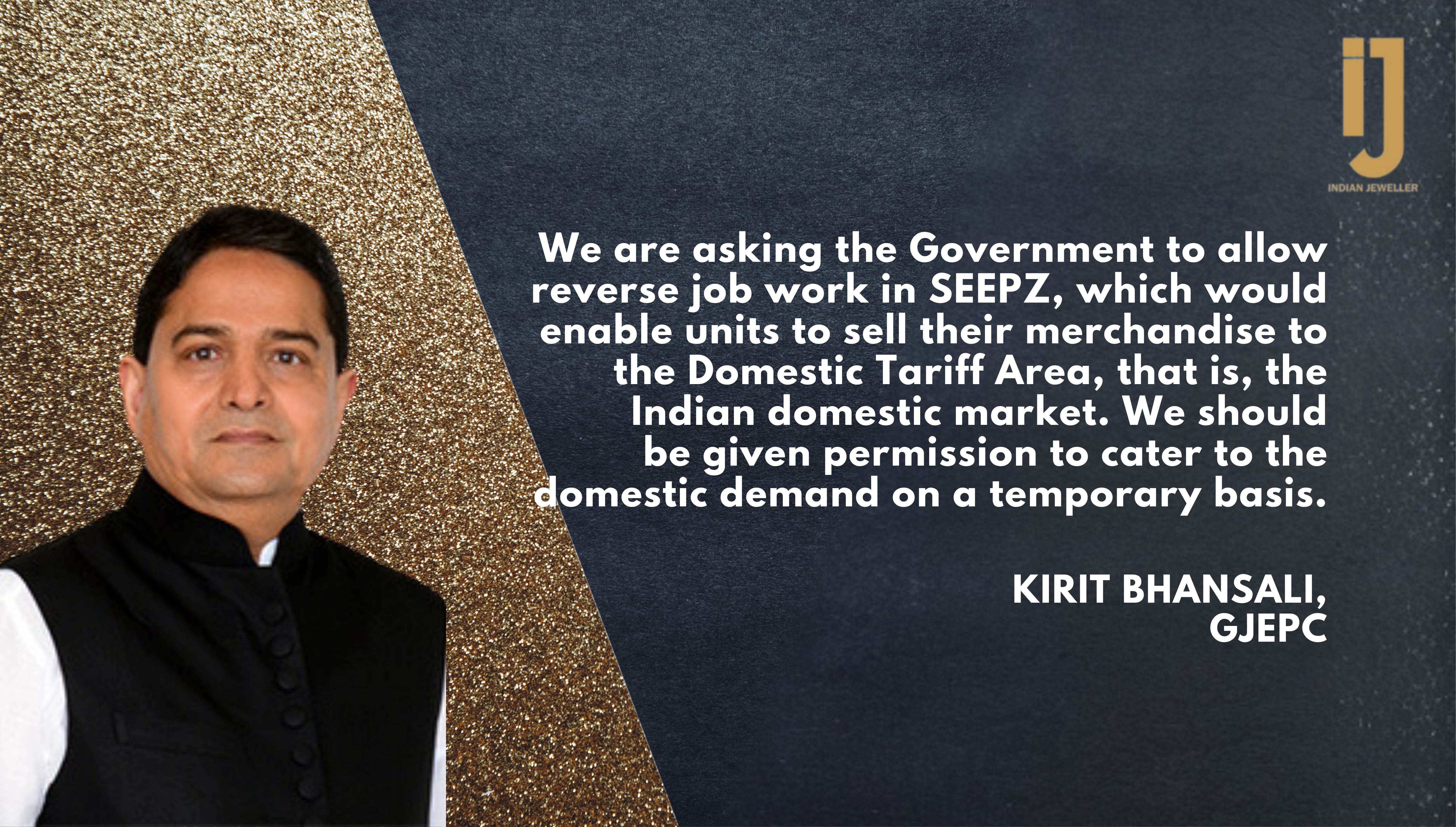With the steep Trump tariffs now having come into play, the cutting, polishing, manufacturing and export hubs of India are facing severe problems, with joblessness and unit-closure a distinct possibility. The silver lining is that the GJEPC is hopeful of a solution, particularly in view of the advocacy efforts of its US counterparts, who are also working hard to impress upon the Trump administration that the high tariffs will have a deleterious effect on the US jewellery industry as well. In a free-wheeling conversation with Suneeta Kaul, Kirit Bhansali, Chairman, GJEPC, talks about the impact of the tariffs, the steps being taken to bring about some relief to the industry, its expectation from the government, and more.

Q: What has been the immediate impact of the 50% tariffs on polished diamond exports of India announced by the Trump administration?
A: Well, the trade between the US and India is totally on hold. No exporter is in a position to carry on business, and there is a standstill, as of now. No exports are happening. Both jewellery and loose diamonds are suffering.
Q: How bad is the situation in terms of job losses and human distress?
A: The social and employment fallout is a major cause of worry. India’s diamond polishing hubs are very labour-intensive. The sector employs over 10 lakh workers directly and indirectly -- many of them are now grappling with reduced working days, resulting in lower wages.
In the SEEPZ SEZ, which is a key part of India’s gem and jewellery exports, particularly studded diamond jewellery, 65% to 70% of the supply goes to the US. If things continue the way they are now, there will be a major problem of joblessness in this hub.
The Surat cluster is also facing a similar problem -- a large workforce of the industry is in Surat alone. Then there are manufacturing clusters in Sitapura (Jaipur) and Noida, which also employ a sizeable workforce. Out of every 15 diamonds, 14 are cut and polished in India, and 30% of the total export goes to the US. With such a large workforce employed by this industry, the human factor is, naturally, worrisome.

Q: What steps are being taken to alleviate the situation?
A: We are working hard to bring about some relief for the industry, and the workers. We have met the Commerce and Industry Minister Piyush Goyal three times. Next week, I am meeting Finance Minister Nirmala Sitharaman. We have also written to the Prime Minister, explaining the situation, and seeking his intervention.
Fortunately, a representative of the diamond industry is a Rajya Sabha MP (diamond tycoon Govind Dholakia, founder and chairman of Shree Ramkrishna Exports). He is one of the biggest exporters of diamonds and diamond jewellery, exporting majorly to the US. He is also pursuing this matter, and is in touch with the Minister of External Affairs, S Jaishankar.
Besides, we have approached the concerned state governments also. I have met the chief minister of Maharashtra twice, and am in touch with the chief ministers of Gujarat and Rajasthan.
Q: What is GJEPC’s expectation from the government?
A: Our submission is that the Government should give some financial relief to the workers of the diamond cutting and polishing units, and others employed by the industry. What we are telling the Government of India is that the domestic market is booming. There is a huge demand within India. India’s 7.8% GDP growth in the first quarter of FY 2026, despite global headwinds, like the recent US tariff, reflects the resilience of our economy.
We have now emerged as one of the leading jewellery consuming markets globally, with diamond jewellery alone accounting for $ 8.5 billion — nearly 10% of the world demand. With rising incomes, a young aspirational population, and growing investor confidence, we believe India’s share of global diamond consumption will rise significantly, from the current 10% to as much as 30% in the coming years. Already, the domestic diamond jewellery market has shown strong double-digit growth in the past three years, growing by 11% to 15%.
So, we are asking the Government to allow reverse job work in SEEPZ, which would enable units to sell their merchandise to the Domestic Tariff Area, that is, the Indian domestic market. As of now, we have permission to only export from SEEPZ, we cannot divert the supply to the domestic market. What we are saying is that we should be given permission to cater to the domestic demand on a temporary basis. This way, the workers employed in the SEEPZ units can be gainfully employed, and it will help the entire industry.

Q: What has the government response been like?
A: The government is taking our demand very seriously. I had a meeting with Niti Aayog, and also with officials of the Commerce Ministry. And, as I said, next week, I will meet Finance Minister Nirmala Sitharaman. I am hopeful that reverse job work will be allowed by the Government.
The state governments are also being helpful. We have had a good response from the Gujarat government, which has agreed to set up a committee to look into the matter. It has also agreed to release a financial package for those impacted by the tariff problem. Simple things like waiving the school fee of the children of the workers employed by the diamond cutting, polishing and exporting industry for a brief period of time, say for six months, can help.
Besides, we have also requested that interest should not be charged on delayed EMIs of those from the industry who might have taken loans. These steps can alleviate the problem of the people whose lives have been thrown out of gear by this very unwelcome development. We are in touch with the Rajasthan government also. Compared to the diamond industry, the colour gemstone industry is very small. But it will also face the impact of the tariffs.
Q: What are your counterparts in the US conveying to you?
A: We are talking with various associations of the US, and my counterparts there are telling me to just lie low for some time, and have patience. They are sure something can be worked out to the advantage of both the parties.
There are about 70,000 small and big jewellery retail outlets in the US, and India is the biggest supplier to them. They are also very perturbed by this development. Their customers are not in a position to pay the steeply hiked prices of jewellery, post the announcement of the tariffs.
The US lobbies are also hard at work. International Diamond Manufacturers Association (IDMA) has approached the Washington counterparts, and met with the US government officials. They are trying to impress upon their government that India is a good partner. Our retailers (US retailers) are making good money. Their operational margin is 60% to 100%. Whereas Indian exporters are doing between 4% to 6% margin, some at 8%.
If we look at it from the lens of sheer economics, financially, the US retailers will be bigger losers than us. Another thing is that Indians are giving them 120 days to 180 days credit. Sometimes 210 days also. They do not have any immediate replacement who can give them credit of the kind Indian exporters do. So, their entire gem and jewellery business is banking on India. The US trade organizations and their trade bodies are trying to convince the US government that there can be a major problem of joblessness in the US also if things persist the way they are now.

Q: Has the time come to look for alternate export markets?
A: Absolutely! We are in touch with countries such as Vietnam, the Latin American nations, the Gulf nations, particularly Saudi Arabia and the UAE, Australia and Canada. We are doing B2B shows in these countries. We are inviting them to visit us, and our people are going there. Even if there is some solution to the tariff issue, we should reduce our dependence on just one market. And that is what we are working towards.
Be the first to comment